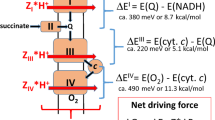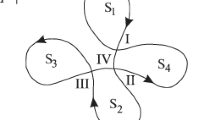Abstract
Two theoretical approaches applied to oxidative phosphorylation, namely Metabolic Control Analysis (MCA) [1-7] and Non-Equilibrium Thermodynamics (NET) [8-11], turned out to be very useful tools for quantitative description and understanding of control and regulation of this process. However, they were not able to predict any new properties of the considered system. On the other hand, the previously developed dynamic model of oxidative phosphorylation [12-17], representing a kinetic approach, allowed to formulate several interesting predictions which can be tested experimentally. The most important of these predictions are: (1) Different steps of ATP-production must be directly activated to a similar extent as ATP-consumption during stimulation of ATP turnover by calcium-acting hormones as well as by neural signals during muscle contraction; (2) A universal activator/regulatory mechanism responsible for such a precise balance of activation should be identified; (3) The flux-force relationship for cytochrome oxidase can be inverse during the transition towards hypoxia and anoxia, when oxygen concentration falls below 30 μM; (4) The flux-force relationship can depend on the way in which the thermodynamic force is changed; (5) The pattern of metabolic control is completely different in normoxic and hypoxic conditions; in the latter case cytochrome oxidase has the flux control coefficient close to unity. Thus, the kinetic model of oxidative phosphorylation seems to be a useful scientific tool, offering some novel theoretical predictions, which then can be tested in the experimental way.
Similar content being viewed by others
References
Kacser H, Burns JA: The control of flux. Symp Sos Exp Biol 32: 61–104, 1973
Heinrich R, Rapoport TA: A linear steady-state treatment of enzymatic chains. General properties, control and strength. Eur J Biochem 42: 89–95, 1974
Groen AK, Wanders RJA, Westerhoff HV, van der Meer R, Tager JM: Quantification of the contribution of various steps to the control of mitochondrial respiration. J Biol Chem 257: 2754–2757, 1982
Lettelier T, Malgat M, Mazat J-P: Control of oxidative phosphorylation in rat muscle mitochondria: Implications for mitochondrial myopathies. Biochim Biophys Acta 1141: 58–64, 1993
Jouaville L, Ichas F, Lettelier T, Mazat J-P: Control of ATP flux in rat muscle mitochondria. In: S Schuster, M Rigoulet, R Ouabi, J-P Mazat (eds). Modern Trends in BioThermoKinetics. Plenum Press, New York, 1993, pp 319–325
Fell DA: Metabolic Control Analysis: A survey of its theoretical and experimental development. Biochem J 286: 313–330, 1992
Brown GC: Control of respiration and ATP synthesis in mammalian mitochondria and cells. Biochem J 284: 1–13, 1992
Rottenberg H: The thermodynamic description of enzyme-catalyzed reactions. Biophys J 13: 503–511, 1973
Rottenberg H: Non-equilibrium thermodynamics of energy conversion in bioenergetics. Biochim Biophys Acta 549: 225–253, 1979
Westerhoff HV, van Dam K: Thermodynamics and control of free-energy transduction, Elsevier, Amsterdam, 1987
Stucki JW: The optimal efficiency and the economic degrees of coupling of oxidative phosphorylation. Eur J Biochem 109: 269–283, 1980
Korzeniewski B, Froncisz W: An extended dynamic model of oxidative phosphorylation. Biochim Biophys Acta 1060: 210–223, 1991
Korzeniewski B, Froncisz W: Theoretical studies on the control of the oxidative phosphorylation system. Biochim Biophys Acta 1102: 67–75, 1992
Korzeniewski B: Simulation of oxidative phosphorylation in hepatocytes. Biophys Chem 58: 215–224, 1996
Korzeniewski B: Simulation of state 4 → state 3 transition in isolated mitochondria. Biophys Chem 57: 143–153, 1996
Korzeniewski B: Regulation of cytochrome oxidase: Theoretical studies. Biophys Chem 59: 75–86, 1996
Korzeniewski B, Mazat J-P: Theoretical studies on the control of oxidative phosphorylation in muscle mitochondria: Application to mitochondrial deficiencies. Biochem J 319: 143–148, 1996
Mitchell P: Coupling of phosphorylation to electron and hydrogen transfer by a chemiosmotic-type of mechanism. Nature 191:144–148, 1961
Chance B, Williams GR: Respiration enzymes in oxidative phosphorylation. l. Kinetics of oxygen utilization. J Biol Chem 217: 383–393, 1955
Chance B, Williams GR: The respiratory chain and oxidative phosphorylation. Adv Enzymol 17: 65–134, 1956
Nicholls DG: The influence of respiration and ATP hydrolysis on the proton-electrochemical gradient across the inner membrane of rat-liver mitochondria as determined by ion distribution. Eur J Biochem 50: 305–315, 1974
Duszyäski J, Bogucka K, Wojtczak L: Homeostasis of the protonmotive force in phosphorylating mitochondria. Biochim Biophys Acta 767: 540–547, 1984
Bohnensack R, Gellerich FN, Schild L, Kunz W: The function of the adenine nucleotide translocator. Biochim Biophys Acta 1018: 182–184, 1990
Smith CM, Bryla J, Williamson JR: Regulation of mitochondrial α-ketoglutarate metabolism by product inhibition at α-ketoglutarate dehydrogenase. J Biol Chem 249: 1497–1505, 1974
Wilson DF, Ereciriska M, Drown C, Silver IA: The oxygen dependence of cellular energy metabolism. Arch Biochem Biophys 195: 485–493, 1979
Kashiwagura T, Wilson DF, Ereciäska M: Oxygen dependence of cellular metabolism: the effect of O2 tension on gluconeogenesis and urea synthesis in isolated rat hepatocytes. J Cell Physiol 120: 13–18, 1984
Gnaiger E, Steinlechner-Maran R, Mendez G, Eberl T, Margerite R: Control of mitochondrial and cellular respiration by oxygen. J Bioenerg Biomembr 27: 583–596, 1995
Wanders RJA, Westerhoff HV: Sigmoidal relation between mitochondrial respiration and log([ATP]/[ADP])out under conditions of extramitochondrial ATP utilization. Implications for the control and thermodynamics of oxidative phosphorylation. Biochemistry 27: 7832–7840, 1988
Hafner RP, Brown GC, Brand MD: Analysis of the control of respiration rate, phosphorylation rate, proton leak rate and protonmotive force in isolated mitochondria using the ‘top-down’ approach of metabolic control theory. Eur J Biochem 188: 313–319, 1990
Brown GC, Lakin-Thomas PL, Brand MD: Control of respiration and oxidative phosphorylation in isolated rat liver cells. Eur J Biochem 192: 355–362, 1990
Small JR, Kacser H: Responses of metabolic systems to large changes in enzyme activities and effectors. 1. The linear treatment of unbranched chains. Eur J Biochem 213: 613–624, 1993
Small JR, Kacser H: Responses of metabolic systems to large changes in enzyme activities and effectors. 2. The linear treatment of branched pathways and metabolite concentrations. Assessment of the general non-linear case. Eur J Biochem 213: 625–640, 1993
Small JR, Kacser H: A method for increasing the concentration of a specific internal metabolite in steady-state systems. Eur J Biochem 226: 649–656, 1994
Bohnensack R: Control of energy transformation in mitochondria: Analysis by a quantitative model. Biochim Biophys Acta 634: 201–218, 1981
Bohnensack R, Kuster U, Letko G: Rate-controlling steps of oxidative phosphorylation in rat liver mitochondria; a synoptic approach of model and experiment. Biochim Biophys Acta 680: 271–280, 1982
Korzeniewski B, Mazat J-P: Theoretical studies on control of oxidative phosphorylation in muscle mitochondria at different energy demands and oxygen concentrations. Acta Biotheoretica 44: 263–269, 1996
Taylor WM, Van de Pol E, Bygrave FL: On the stimulation of respiration by α-adrenergic agonists in perfused rat liver. Eur J Biochem 155: 319–322, 1986
Kimura S, Suzaki T, Kobayashi S, Abe K, Ogata E: Effects of glucagon on the redox states of cytochromes in mitochondria in situ in perfused rat liver. Biochem Biophys Res Comm 119: 212–219, 1984
Strzelecki T, Thomas JA, Koch CD, LaNoue KF: The effect of hormones on proton compartmentation in hepatocytes. J Biol Chem 259: 4122–4129, 1984
Titheridge MA, Haynes RC: The hormonal stimulation of ureogenesis in isolated hepatocytes through increases in mitochondrial ATP production. Arch Biochem Biophys 201: 44–55, 1980
Quinlan PT, Halestrap AP: The mechanism of the hormonal activation of respiration in isolated hepatocytes and its importance in the regulation of gluconeogenesis. Biochem J 236: 789–800, 1986
Brand MD, Murphy MP: Control of electron flux through the respiration chain in mitochondria and cells. Biol Rev 62: 141–193, 1987
Tager JM, Groen AK, Wanders RJA, Duszyriski J, Westerhoff HV, Vervoorn RC: Control of mitochondrial respiration in rat-liver cells. In: RA Harris, NW Cornell (eds). Isolation characterization and use of hepatocytes. Elsevier, Amsterdam, 1983, pp 313–322
Korzeniewski B, Harper M-E, Brand M: Proportional activation coefficients during stimulation of oxidative phosphorylation by lactate and pyruvate or by vasopressin. Biochim Biophys Acta 1229: 315–322, 1995
Akerboom TM, Bookelman H, Tager JM: Control of ATP transport across the mitochondrial membrane in isolated rat-liver cells. FEBS Lett 74: 50–54, 1977
Lemasters JJ, Sowers AK: Phosphate dependence of and actractyloside inhibition of mitochondrial oxidative phosphorylation. J Biol Chem 254: 1248–1251, 1979
Ereciäska M, Stubbs M, Miyata Y, Ditre CM, Wilson DF: Regulation of cellular metabolism by intracellular phosphate. Biochim Biophys Acta 462: 20–35, 1977
Hassinen JE: Mitochondrial respiratory control in the myocardium. Biochim Biophys Acta 853: 135–151, 1986
Atkinson DE: The energy charge of the adenylate pool as a regulatory parameter. Interaction with feedback modifiers. Biochemistry 7: 4030–4034, 1968
Korzeniewski B: What regulates respiration in mitochondria? Biochem Molec Biol Int 39: 415–419, 1996
Denton RM, McCormack JG: On the role of the calcium cycle in heart and other mammalian mitochondria. FEBS Lett 119: 1–8, 1980
Hansford RG: Control of mitochondrial substrate oxidation. Curr Top Bioenerg 10: 217–278, 1980
McCormack JG, Halestrap AP, Denton RM: Role of calcium ions in regulation of mammalian intramitochondrial metabolism. Physiol Rev 70: 391–425, 1990
McCormack JG, Denton RM: The role of mitochondrial Ca2+ transport and matrix Ca2+ in signal transduction in mammalian tissues. Biochim Biophys Acta 1018: 287–291, 1990
Harris DA, Das AM: Control of mitochondrial ATP synthesis in the heart. Biochem J 280: 561–573, 1991
Moreno-Sanchez R, Hogue BA, Hansford RG: Influence of NAD-linked dehydrogenase activity on flux through oxidative phosphorylation. Biochem J 268: 421–428, 1990
Balaban RS, Kantor HL, Katz LA, Briggs RW: Relation between work and phosphate metabolite in the in vivo paced mammalian heart. Science 232: 1121–1123, 1986
Katz LA, Swain JA, Portman MA, Balaban RS: Relation between phosphate metabolites and oxygen consumption of heart in vivo. Am J Physiol 256: H265–H274, 1989
Balaban RS, Heineman FW: Control of mitochondrial respiration in the heart in vivo. Mol Cell Biochem 89: 191–197, 1989
Heineman FW, Balaban RS: Control of mitochondrial respiration in the heart in vivo. Annu Rev Physiol 52: 523–542, 1990
Kacser H, Acerenza L: A universal method for achieving increases in metabolite production. EurJ Biochem 216: 361–367, 1993
Korzeniewski B: Regulation of ATP supply during muscle contraction. Biochem (in press)
Krämer R, Mayr U, Heberger C, Tsompanidou S: Activation of the ADP/ATP carrier from mitochondria by cationic effectors. Biochim Biophys Acta 855: 201–210, 1986
Korzeniewski B, Froncisz W: Thermodynamic response paradigm and its application to oxidative phosphorylation. In: S Schuster, M Rigoulet, R Ouabi, J-P Mazat (eds). Modern Trends in BioThermoKinetics. Plenum Press, New York, 1993, pp 33–38
Author information
Authors and Affiliations
Rights and permissions
About this article
Cite this article
Korzeniewski, B. Is it possible to predict any properties of oxidative phosphorylation in a theoretical way?. Mol Cell Biochem 184, 345–358 (1998). https://doi.org/10.1023/A:1006881618134
Issue Date:
DOI: https://doi.org/10.1023/A:1006881618134




